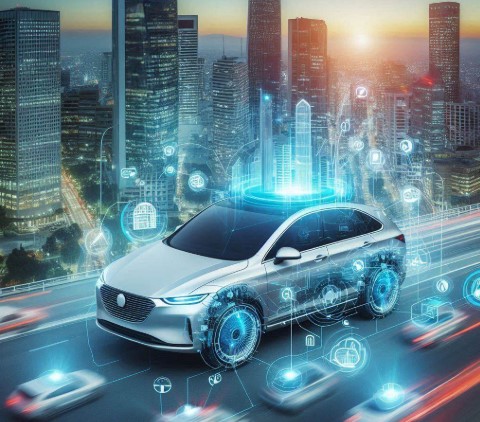The Future of Driving: Exploring the Rise of Autonomous Vehicle Technology
Introduction
The automotive industry is undergoing a profound transformation, driven by rapid advancements in technology. At the forefront of this evolution is the rise of autonomous vehicles (AVs), often referred to as self-driving cars. These vehicles promise to revolutionize not only how we drive but also the infrastructure of cities, transportation logistics, safety standards, and the global economy. This article delves into the development, challenges, societal impact, and future prospects of autonomous vehicle technology.
The Evolution of Autonomous Vehicles
Autonomous vehicle technology is not a recent invention; its conceptual roots date back to the mid-20th century. However, significant progress began in the 1980s with projects like Carnegie Mellon University’s Navlab and Mercedes-Benz’s Eureka Prometheus Project. These early experiments laid the groundwork for modern AV development.
In the 21st century, technological advancements in artificial intelligence (AI), machine learning, sensor systems, and high-speed computing have catalyzed AV progress. Companies like Google (now Waymo), Tesla, Uber, and legacy automakers like General Motors and Ford have invested billions into autonomous driving technologies. The development of sophisticated systems such as LiDAR, radar, GPS, and computer vision has been crucial in enabling AVs to perceive their surroundings accurately and make real-time decisions.
Levels of Autonomy
The Society of Automotive Engineers (SAE) has defined six levels of driving automation, from Level 0 (no automation) to Level 5 (full automation):
• Level 0: No automation. The human driver controls all aspects.
• Level 1: Driver Assistance. Basic features like adaptive cruise control.
• Level 2: Partial Automation. The vehicle can control steering and acceleration but requires human oversight.
• Level 3: Conditional Automation. The vehicle can handle driving tasks under specific conditions, with the driver ready to intervene.
• Level 4: High Automation. The vehicle performs all driving functions in specific environments.
• Level 5: Full Automation. No human intervention is needed under any conditions.
As of today, most commercially available AVs operate at Levels 2 or 3. Fully autonomous Level 5 vehicles remain in the testing and development phase.
Core Technologies Behind AVs
Several core technologies enable autonomous vehicles to function effectively:
• Sensors and Actuators: AVs use a combination of LiDAR, radar, ultrasonic sensors, and cameras to perceive their environment.
• Connectivity: Vehicle-to-everything (V2X) communication allows AVs to share data with other vehicles, infrastructure, and cloud systems.
• Artificial Intelligence: Machine learning algorithms process sensor data to identify objects, predict behavior, and make driving decisions.
• Mapping and Localization: High-definition maps and GPS technology help AVs navigate accurately.
• Control Systems: These systems translate decisions made by the AI into physical actions like steering, braking, and accelerating.
Current Industry Landscape
Numerous companies are actively developing and testing AV technologies:
• Waymo: A pioneer in AV development, operating a robotaxi service in select U.S. cities.
• Tesla: Focused on advanced driver-assistance systems (ADAS) with ambitions for full autonomy.
• Cruise (GM) and Argo AI (Ford/Volkswagen): Working on ride-hailing services and urban mobility solutions.
• Apple and Amazon: Investing heavily in autonomous systems, though their projects are more secretive.
Governments around the world are also shaping regulations to accommodate AVs, with countries like the U.S., Germany, and China leading in pilot programs and infrastructure development.
Benefits of Autonomous Vehicles
The rise of AVs is expected to bring numerous benefits:
• Safety: AVs can potentially reduce accidents caused by human error, which accounts for over 90% of traffic incidents.
• Efficiency: Optimized traffic flow and reduced congestion through intelligent routing and speed control.
• Accessibility: Improved mobility for the elderly, disabled, and those unable to drive.
• Environmental Impact: Electric AVs can contribute to lower emissions and more sustainable urban planning.
• Economic Productivity: Commuters can utilize travel time for work or leisure, boosting productivity.
Challenges and Concerns
Despite the promise, AV technology faces significant hurdles:
• Technical Challenges: Ensuring reliability in complex environments like urban streets with unpredictable elements.
• Ethical Dilemmas: Programming AVs to make decisions in unavoidable accident scenarios raises moral questions.
• Legal and Regulatory Issues: Establishing liability in case of accidents and developing international standards.
• Security: Protecting AV systems from cyberattacks and ensuring data privacy.
• Public Trust: Building consumer confidence in AV safety and reliability.
Societal and Economic Impact
The widespread adoption of AVs will have profound implications:
• Job Displacement: Automation could impact millions of driving-related jobs (e.g., truck drivers, taxi services).
• Urban Development: Changes in infrastructure needs, such as reduced parking space and redesigned roadways.
• Insurance and Legal Systems: Shift from driver liability to manufacturer and software accountability.
• Data Economy: AVs generate massive data, opening opportunities for new business models and services.
Global Adoption and Timeline
Adoption rates will vary across regions, influenced by technological readiness, regulatory frameworks, and public acceptance. Experts predict:
• By 2030: Level 4 AVs may become common in urban areas and commercial fleets.
• By 2040–2050: Broader adoption of Level 5 AVs, especially in developed nations.
Asia, North America, and Europe are expected to lead, with infrastructure investment and supportive policies playing a key role.
The Road Ahead
To realize the full potential of AVs, collaboration across industries, governments, and communities is essential. Key priorities include:
• Enhancing AI capabilities for edge-case scenarios.
• Creating robust regulatory frameworks.
• Promoting ethical guidelines for autonomous decision-making.
• Investing in infrastructure such as 5G networks and smart roads.
• Educating the public on AV benefits and safety measures.
Conclusion
Autonomous vehicle technology represents one of the most transformative innovations in modern transportation history. While challenges remain, the potential benefits to safety, efficiency, and societal well-being are immense. As we stand on the cusp of a driverless future, it is crucial to steer this technological revolution responsibly, ensuring that the road ahead is paved with foresight, inclusivity, and innovation.
________________________________________



